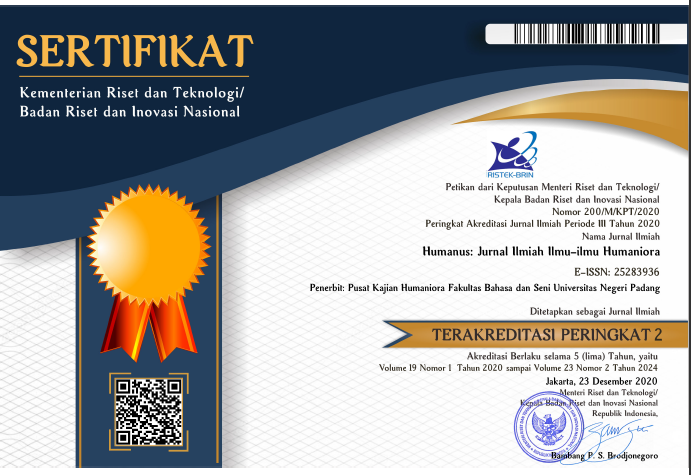Power and Branding: Language Commodification of Tourist Resorts
 ), Ika Maratus Sholikhah(2), Erna Wardani(3),
), Ika Maratus Sholikhah(2), Erna Wardani(3), (1) Universitas Jenderal Soedirman, Central Java
(2) Universitas Jenderal Soedirman, Central Java
(3) Universitas Jenderal Soedirman, Central Java
 Corresponding Author
Corresponding Author
Copyright (c) 2021 Humanus
DOI : https://doi.org/10.24036/humanus.v20i1.111026
Full Text:
 Language : en
Language : en
Abstract
Keywords
References
Akindele, D. O. (2011). Linguistic Landscapes as Public Communication: A Study of Public Signage in Gaborone Botswana. International Journal of Linguistics, 3(1), 39. https://doi.org/10.5296/ijl.v3i1.1157
Ardi, H. (2018). Local Language Maintenance in Translating English Text. JEELL (Journal of English Education, Linguistics and Literature), 5(1), 101. https://doi.org/10.32682/jeell.v5i1.980
Aribowo, E. K., Rahmat, & Arif Julianto Sri Nugroho. (2018). Aancangan analisis bahasa di ruang publik: Studi lanskap linguistik Kota Surakartadalam mempertahankan tiga identitas. Semiloka Dan Deklarasi Pengutamaan Bahasa Negara, 8(2), 1–8. https://doi.org/https://doi.org/10.31227/osf.io/qa5p8
Asfina, R., & Ovilia, R. (2017). Be proud of Indonesian cultural heritage richness and be alert of its preservation efforts in the global world. Humanus: Jurnal Ilmiah Ilmu-Ilmu Humaniora, 15(2), 195. https://doi.org/10.24036/jh.v15i2.6428
Badan Pusat Statistik. (2021). Jumlah Pengunjung Obyek Wisata di Kabupaten Banyumas. Badan Pusat Statistik.
Barni, M., & Bagna, C. (2009). A mapping technique and the linguistic landscape. In E. Shohamy & D. Gorter (Eds.), Linguistic Landscape: Expanding the Scenery. Routledge.
Ben-Rafael, E., Shohamy, E., Amara, M. H., & Trumper-Hecht, N. (2006). Linguistic Landscape as Symbolic Construction of the Public Space: The Case of Israel. In D. Gorter (Ed.), Linguistic Landscape: A New Approach to Multilingualism (1st ed., pp. 7–30). Multilingual Matters Ltd.
Block, D. (2017). What on earth is‘language commodification.
Blommaert, J. (2003). Commentary: A sociolinguistics of globalization. Journal of Sociolinguistics, 7(4), 607–623. https://doi.org/10.1111/j.1467-9841.2003.00244.x
Cenoz, J., & Gorter, D. (2006). Linguistic landscape and minority languages. International Journal of Multilingualism, 3(1), 67–80. https://doi.org/10.21832/9781853599170-005
Cohen, E. (1988). Authenticity and Commoditization in Tourism. Annal of Tourism Research, 15(1), 371–386. https://doi.org/10.1111/j.1745-6592.2010.01279.x
Creswell, J. W. (2009). Research design: Qualitative, quantitative, and mixed methods approaches. Research Design Qualitative Quantitative and Mixed Methods Approaches, 3rd, 260. https://doi.org/10.1016/j.math.2010.09.003
Dewi, U. P. (2017). Commodification of language in globalization context: Global and local interconnection of English valuing in Indonesian magazine advertisement. Advanced Science Letters, 23(1), 562–565. https://doi.org/10.1166/asl.2017.7255
Erikha, F. (2018). Konsep Lanskap Linguistik Pada Papan Nama Jalan Kerajaan (Râjamârga): Studi Kasus Di Kota Yogyakarta. Paradigma, Jurnal Kajian Budaya, 8(1), 38–52. https://doi.org/10.17510/paradigma.v8i1.231
Heller, M. (2010). The commodification of language. Annual Review of Anthropology, 39, 101–114. https://doi.org/10.1146/annurev.anthro.012809.104951
Heller, M., Pujolar, J., & Duchêne, A. (2014). Linguistic commodification in tourism. Journal of Sociolinguistics, 18(4), 539–566. https://doi.org/10.1111/josl.12082
Jamzaroh, S. (2019). The language attitude of culinary entrepreneurs in Banjarmasin. Humanus: Jurnal Ilmiah Ilmu-Ilmu Humaniora, 18(2), 208–223. https://doi.org/10.24036/humanus.v18i2.107171
Law No 24 on The National Flag, Language, Emblem and Anthem, (2009).
Leeman, J., & Modan, G. (2010). Selling the city: Language, ethnicity and commodified space. In E. Shohamy, E. Ben-Rafael, & M. Barni (Eds.), Linguistic Landscape in the City (pp. 182–198). Multilingual Matters Ltd. https://doi.org/10.21832/9781847692993-012
Meekaew, N., & Srisontisuk, S. (2012). Proceedings-Management, Agroindustry and Tourism Industry-004 4 th International Conference on Humanities and Social Sciences Chiangkhan: Cultural Commodification for Tourism and its Impact on Local Community. 4th International Conference on Humanities and Social Science, 1–8.
Rabiah, S. (2012). Language as a Tool for Communication and Cultural Reality Discloser. 1st International Conference on Media, Communication and Culture “Rethinking Multiculturalism: Media in Multicultural Society", 1–11. https://doi.org/10.31227/osf.io/nw94m
Tan, P. K., & W.;Rubdy, R. (2008). Language as Comodity: Global Structure, Local Marketplace (1st ed.). Continuum International Publishing Group.
Watson, G. L., & Kopachevsky, J. P. (1994). Interpretations of tourism as commodity. Annals of Tourism Research, 21(3), 643–660. https://doi.org/10.1016/0160-7383(94)90125-2
Wee, L. (2008). Linguistic Instrumentalism in Singapore. In R. Tan, Peter K.W.;Rubdy (Ed.), Language as Commodity Global Structures, Local Marketplaces (1st ed., pp. 31–43). Continuum International Publishing Group.
Widiyatno, E. (2019). Baturraden Masuk Nominasi API Award 2019. Republika.
 Article Metrics
Article Metrics
 Abstract Views : 519 times
Abstract Views : 519 times
 PDF Downloaded : 196 times
PDF Downloaded : 196 times
Refbacks
- There are currently no refbacks.
Copyright (c) 2021 Humanus

This work is licensed under a Creative Commons Attribution-NonCommercial 4.0 International License.










